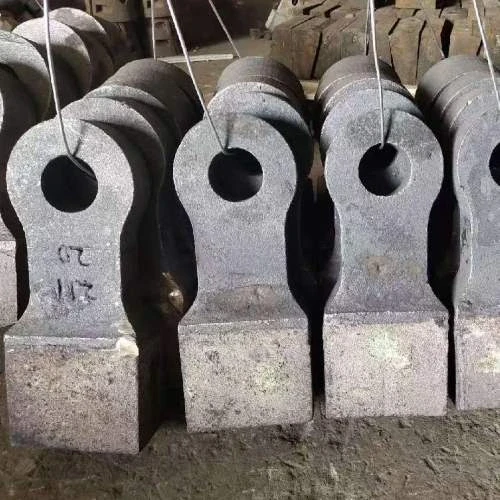Oct . 10, 2025 09:30 Back to list
Manganese Steel Plate: Hadfield Toughness, Wear Resistance?
What’s Really Going On With the manganese steel plate Market
Wear steel isn’t glamorous, but when your chute liner outlasts the shutdown window by six months, you remember it. Lately, demand for manganese steel plate (the classic Hadfield/X120Mn12 stuff) has picked up in mining, aggregates, even recycling. Some say it’s old-school. True, but it keeps proving itself—especially where high impact meets moderate abrasion. To be honest, that sweet spot is wider than most folks expect.
Quick refresher: why manganese works
Hadfield-grade manganese steel plate arrives relatively soft (≈200 HB), then work-hardens on impact up toward 450–550 HB. The austenitic matrix keeps it tough, so it resists cracking while the surface hardens in service. That dual personality is why it thrives in crusher liners, shot-blast cabinets, rail crossings—places where mild steel just cries uncle.

Typical product specs (real-world use may vary)
| Grade | X120Mn12 / DIN 1.3401 (Hadfield) |
| Chemistry (wt%) | C ≈1.1–1.4, Mn ≈11–14, Si ≤1.0, P ≤0.07, S ≤0.03 |
| Supply condition | Solution-annealed ≈1050–1100°C and water-quenched |
| Thickness range | ≈6–60 mm common; wider/thicker on request |
| Hardness | As-delivered ≈180–220 HB; work-hardened ≈450–550 HB |
| UTS / YS / A% | ≈800–1100 MPa / ≈350 MPa / ≥30–40% |
| Testing | UT per ASTM A578; Tensile ASTM E8; Hardness ASTM E10; Abrasion ASTM G65 |
| Flatness | Typically per EN 10029 (Class N) |
Process flow (shop-floor version)
- Raw materials: high-purity FeMn, carburizers; tight S and P control
- Melting: EAF or basic oxygen; alloying to hit 1.1–1.4% C and 11–14% Mn
- Slab casting → hot rolling to final gauge
- Solution anneal at ≈1050–1100°C, rapid water quench to lock austenite
- Straightening, shot-blast, pickling as needed
- NDT/QA: UT (ASTM A578 Level C typical), mechanicals, PMI/chem
Where it earns its keep
Mining and quarry chute liners, gyratory and jaw crusher liners, loader bucket lips, shredder grids, shot-blast cabinets, cement clinker handling, and yes, railway frogs and crossings. In heavy impact duty, customers report 2–4× service life versus AR400—sometimes more, sometimes less, depending on whether the surface “work hardens” enough. If it doesn’t see impact, a harder chromium carbide plate may be smarter.
Case notes (short and honest)
Iron ore chute, 20 mm manganese steel plate: switched from mild steel. After 9 months, field hardness mapped at 480–520 HB (portable tester), wear rate down ≈55% vs baseline; no through-cracks. The crew liked that it “bruises hard but doesn’t snap”—their words, not mine.
Vendor landscape (and a quick curveball)
Not every site needs only plate. In crushers, pairing manganese steel plate liners with high-chrome impact parts can be a killer combo. Example: Chengda’s High Chrome Hammer Head—cast high-chromium iron, quenched for stable performance—often runs upstream of Mn liners in recycling lines.
| Vendor | Focus | Relevant grade/standard | Certs (typical) | Notes |
|---|---|---|---|---|
| Chengda (KIZUN Industry Zone, Luquan, Sihijiazhuang city, Hebei, China) | High Chrome Hammer Head wear parts | High-Cr cast iron; pairs with Mn liners | ISO/QMS on request | Impact-resistant; good for recyclers |
| Vendor A (plate mill) | manganese steel plate | DIN 1.3401 / X120Mn12 | EN 10204 3.1; UT per ASTM A578 | Thick gauges up to 60 mm |
| Vendor B (service center) | Cut-to-size liners | X120Mn12, AFNOR Z120M12 | Traceable heats; PMI | CNC profiling, pre-drilled kits |
Selection tips (because context matters)
- High impact + moderate abrasion: use manganese steel plate.
- Low impact + high abrasion: consider chromium carbide overlay or high-chrome parts.
- Target quench quality and UT quality (A578 Level C for critical liners).
- Ask for solution-anneal documentation and actual Brinell readings.
Testing snapshot (typical lab panel): G65 Proc. A weight loss ≈150–210 mg; Charpy V-notch (RT) ≈100–180 J; Brinell after peening ≈480 HB. Numbers are indicative; your ore and impact spectrum will move the needle.
Wrap-up
Is manganese steel plate the newest trick in the book? Not even close. But when you need a liner that hardens as it fights, it’s still the one I’d bet my shutdown window on—provided it sees real impact and you buy from a mill with tight heat treatment discipline.
References
- ASTM A128/A128M – Standard Specification for Steel Castings, Austenitic Manganese.
- DIN 1.3401 (X120Mn12) – High-manganese austenitic wear-resistant steel designation.
- ASTM A578/A578M – Straight-Beam Ultrasonic Examination of Rolled Steel Plates.
- ASTM G65 – Measuring Abrasion Using the Dry Sand/Rubber Wheel Apparatus.
-
Expert Insights on Fabrica de Molinos de Bolas: Industry Trends & Global Applications
NewsNov.24,2025
-
Expert Insights on Fabricantes de Bolas de Molienda de Acero: Global Applications & Trends
NewsNov.23,2025
-
Leading Fabricantes de Bolas de Molienda: Your Ultimate Guide to Grinding Balls
NewsNov.23,2025
-
Fabricante de Bolas de Molienda – Quality Grinding Balls for Efficient Industry
NewsNov.23,2025
-
Trusted Proveedores de Medios de Molienda for Efficient Industrial Grinding
NewsNov.22,2025
-
Proveedores de Bolas de Molienda: Your Guide to Top Grinding Ball Suppliers & Industry Insights
NewsNov.22,2025
Realted Products
















